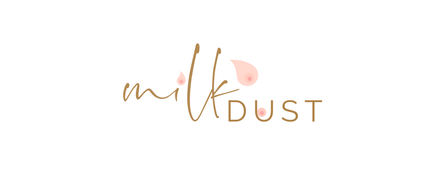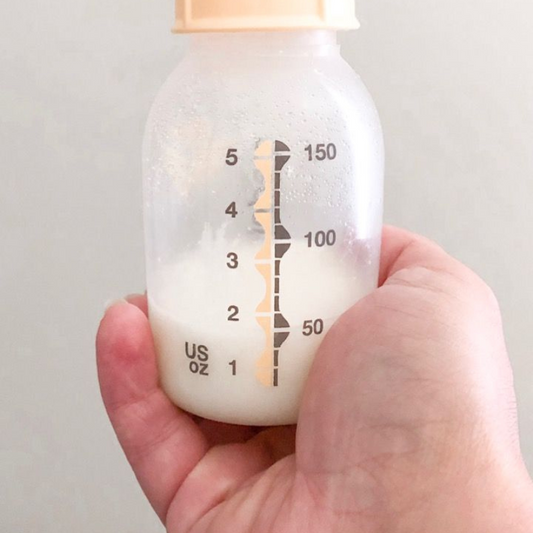Hi there, I'm Katie, a Precicision Nutrition Certified Nutrition Expert and mother to 4 boys. I've been helping new mothers use nutrition to increase breast milk supply while also losing the baby weight for years now. I'm also a Pre/Post Natal Fitness Specialist, focusing on nutrition and fitness for both pregnant and breastfeeding mothers. Nutrition while breastfeeding is so much more than just eating a healthy diet! There are specific nutrients postpartum and lactating mothers need more of, and if these nutrient-needs aren't met, many mothers don't produce enough milk, or their breast milk production slowly drops. As a mom of 4, I've had to lose the baby weight while breastfeeding 4 times, so I've learned exactly what foods increase supply fast, and what foods are a staple for your diet. I can't tell you how many mothers think that they just aren't eating enough, so rather than eat more nutirent-dense foods, they eat more calories. Many times, the influx in calories will give a temporary increase in milk supply because you are giving your body a lot of carbohydrates and fats to push towards creating more milk, but this doesn't solve the underlying issue.
I also created Milk Dust, a plant-based, breastfeeding protein powder that helps nourish lactating mothers while also increasing milk supply. If you read further, you will learn just a few of the increased nutrient needs for breastfeeding mothers. This is all science knows right now, and I believe that if you are a postpartum or breastfeeding mother, you need more nutrients to sustain a healthy milk supply. The good news is that I know exactly what diet you need to eat to increase your breast milk supply. I know which foods work, which ones don't, and I've created a few breastfeeding diets over the years. If you are looking for a good breastfeeding diet to increase your milk supply, this is a great one. Most of my breastfeeding diet plans work for a vegan diet, and Milk Dust protein powder is also vegan friendly with plant-based proteins and ingredients.
Eating a healthy diet while breastfeeding is essential because many postpartum mothers are undernourished but overfed.
The hard reality is that new mothers often jump on the train of eating more to make more milk, but eating more doesn't always mean eating more nutrients. According to this outline by the University of Washington, describing care and nutrition for postpartum mothers,
"The increase in energy utilization increases needs for some nutrients (e.g., thiamin and niacin). Recommended intakes for other nutrients (e.g., copper, iodine, manganese, biotin, choline, riboflavin, and folate) are increased, based on the amount of the nutrient secreted in milk."
There are numerous vitamins and minerals that a new mom needs more of while breastfeeding. These increased nutrient needs are not satisfied with increasing calories alone, which is why I am such a huge proponent of eating nutrient-dense foods at every snack and meal.
I created Milk Dust as an delicious protein powder that fills all of these nutrient needs in breastfeeding mothers. Milk Dust not only fills the nutrient gaps, it also helps crush sugar cravings and increase milk supply! Milk Dust has a lactation blend that will boost your supply in addition to nourish your body, so low milk supply won't be an issue any more! There are no other safe protein formulas on the market that do all of this together.
When you use Milk Dust in your breastfeeding diet plan, you will be so happy to see how much milk you can produce!
"Milkdust saved my postpartum season!!! I saw ads and took a chance because I was desperate. I started working out consistently and eating very clean at 6 weeks postpartum (second kid) but I kept gaining weight instead of losing it! I was so discouraged and ready to try anything…so I bought milkdust protein powder and the metabolism boost. I started using it as a meal replacement because I wasn’t scared my supply would suffer and in one month I lost 5 pounds and the weight keeps coming off! My supply is great and I am so thankful I found milkdust. It will forever be in my postpartum essentials!"
Lindsey S.
Key nutrients to include in your breastfeeding diet to increase milk supply:
Minerals
Calcium:
Many breastfeeding mothers use calcium from their own bone resorption, and not from actual dietary intake in breast milk. But, it is important that mothers eat enough calcium in order to replace what is taken from their own reserves. Vegan diets can be lower in calcium and healthy fats if not supplemented with specific foods that can replace animal products. The best foods, high in calcium and other nutrients include:
- Dairy Products
- Leafy Greens
- Tofu and Soy Products
- Fortified Whole Grains
- Sardines
- Nuts and Seeds (sesame seeds, flax seeds and pumpkin seeds are great!)
- Legumes
- Broccoli and Broccoli Rabe
- Figs
Iron:
Lactating mothers typically need more iron than non-pregnant, non-lactating women. Iron is an essential mineral that plays a crucial role in the production of hemoglobin, the protein in red blood cells that carries oxygen to tissues and organs. Iron is also required for mamas to produce enough breast milk, as it is a component of lactoferrin, an important protein found in breast milk that helps with iron absorption in the infant's gut. Many lactating mothers who are low in iron also have a low milk supply. Foods that are high in iron include:
- Spinach
- Red Meat
- Poultry
- Fish
- Legumes
Zinc:
Requirements for zinc during lactation are increased above pregnancy and nonpregnancy levels. Zinc is a vital mineral that is transferred to breast milk to support the growth and development of the infant. Adequate zinc intake during lactation ensures that the baby receives an adequate supply of this essential nutrient. Lactating mothers experience increased zinc losses through breast milk. The zinc content of breast milk varies depending on the mother's dietary intake, and the body prioritizes the transfer of zinc to breast milk to meet the baby's needs. This can lead to a greater depletion of maternal zinc stores. Here are some foods high in zinc:
- Lean meats (especially red meat and poultry)
- Seafood (such as oysters, crab, and lobster)
- Dairy products (like milk and yogurt)
- Nuts and seeds (especially pumpkin seeds)
- Legumes (beans, lentils, and chickpeas)
- Whole grains (wheat germ and whole wheat products)
- Fortified cereals
Vitamins
Vitamin D
Vitamin D is essential for the healthy development of the infant's bones and immune system. While the developing fetus can acquire vitamin D from the mother during pregnancy, once the baby is born, breast milk becomes the primary source of nutrition. Therefore, lactating mothers must provide an adequate supply of vitamin D to their infants through breast milk. Lactating mothers have an increased requirement for vitamin D because they need to support their own health and provide sufficient vitamin D for their infants. This additional need is recognized in the dietary recommendations for lactating women. Some of the foods highest in vitamin D include:
-
Fatty Fish: Fatty fish are among the best dietary sources of vitamin D. Examples include:
- Salmon (wild-caught): A 3.5-ounce (100-gram) serving of cooked salmon can provide over 570 IU (International Units) of vitamin D, depending on the type of salmon.
- Mackerel: Mackerel is rich in vitamin D, with a 3.5-ounce serving providing around 360 IU.
- Sardines: Canned sardines, with bones, can offer approximately 272 IU per 3.5-ounce serving.
- Cod Liver Oil: Cod liver oil is extremely high in vitamin D. Just one tablespoon can provide well over 1,000 IU of vitamin D. However, it's important to use cod liver oil in moderation due to its high vitamin A content.
- Egg Yolks: Egg yolks contain some vitamin D. The amount can vary depending on the egg's exposure to sunlight or the hen's diet. On average, one large egg yolk contains about 40 IU of vitamin D.
- Mushrooms: Certain types of mushrooms, such as shiitake and maitake, can provide small amounts of vitamin D when exposed to UV light during growth or processing.
- Fortified Foods: Many foods are fortified with vitamin D to help people meet their dietary needs.
Vitamin A
Lactating mothers have an increased requirement for vitamin A because they need to support their own health and provide sufficient vitamin A for their infants. This additional need is recognized in the dietary recommendations for lactating women. Vitamin A plays a vital role in maintaining healthy vision, skin, and mucous membranes. It is also important for the development of the baby's immune system. Adequate vitamin A intake during infancy can help protect the baby from infections and support overall health. Here are 10 foods high in Vitamin A:
- Liver: Organ meats like beef liver and chicken liver are among the richest sources of vitamin A. Just a small serving of liver can provide several times the daily recommended intake of vitamin A.
- Sweet Potatoes: Sweet potatoes are loaded with beta-carotene, a type of provitamin A that the body can convert into active vitamin A. A single sweet potato can provide several times the daily recommended intake.
- Carrots: Carrots are also rich in beta-carotene, making them an excellent source of vitamin A. One medium-sized carrot can provide more than the daily recommended amount.
- Pumpkin: Pumpkin is another vegetable high in beta-carotene and vitamin A. It can be used in soups, stews, or baked goods.
- Butternut Squash: This winter squash is a good source of beta-carotene and vitamin A. It can be roasted, mashed, or used in various recipes.
- Spinach: Dark leafy greens like spinach are high in vitamin A, particularly in the form of provitamin A carotenoids. Spinach can be added to salads, smoothies, and cooked dishes.
- Kale: Kale is another leafy green that contains a significant amount of vitamin A. It's also a good source of other essential nutrients.
- Mangoes: Mangoes are rich in both vitamin A and vitamin C. They make a delicious and nutritious snack or addition to fruit salads.
- Cantaloupe: Cantaloupe is a melon that provides a good dose of vitamin A. It's a refreshing option in fruit salads and as a standalone snack.
- Red Bell Peppers: Red bell peppers contain beta-carotene and are a good source of vitamin A. They can be eaten raw in salads or as a crunchy snack.
Vitamin B6
There is evidence that low maternal intakes could lead to compromised B6 status in the infant, so an increased intake is suggested for lactating women. Vitamin B in general is really important for breastfeeding mothers, but both Vitamin B6 and Vitamin B12 seem to be the most important ones. Vitamin B6 is a water-soluble vitamin that is transferred from the mother's body to her breast milk. This ensures that the infant receives an adequate supply of vitamin B6, which is essential for their growth and development. Lactating mothers have an increased requirement for vitamin B6 because they need to support their own health and provide sufficient vitamin B6 for their infants. This additional need is recognized in the dietary recommendations for lactating women. Here are some great foods high in vitamin B6:
- Poultry: Chicken and turkey, particularly the breast meat, are good sources of vitamin B6. A 3.5-ounce (100-gram) serving of cooked chicken breast provides about 0.5-0.6 milligrams of vitamin B6.
- Fish: Fish such as salmon, tuna, and trout contain vitamin B6. A 3.5-ounce (100-gram) serving of cooked salmon provides approximately 0.6 milligrams of vitamin B6.
- Lean Meats: Lean cuts of beef, pork, and lamb are good sources of vitamin B6. A 3.5-ounce (100-gram) serving of cooked lean beef provides around 0.5-0.7 milligrams of vitamin B6.
- Brewer's Yeast is actually very high in many B vitamins (and is of course in Milk Dust!)
- Potatoes: Potatoes, particularly the skin, are a decent source of vitamin B6. A medium-sized baked potato provides about 0.7 milligrams of vitamin B6.
- Bananas: Bananas are a good fruit source of vitamin B6. One medium-sized banana contains approximately 0.4 milligrams of vitamin B6.
- Avocado: Avocado is not only rich in healthy fats but also contains vitamin B6. A medium-sized avocado provides around 0.5 milligrams of vitamin B6.
- Legumes: Beans and lentils, such as chickpeas, lentils, and black beans, are good sources of vitamin B6. A 1-cup serving of cooked lentils, for example, contains about 0.2 milligrams of vitamin B6.
- Nuts and Seeds: Sunflower seeds, pistachios, and hazelnuts are among the nuts and seeds with relatively high vitamin B6 content. A 1-ounce (28-gram) serving of sunflower seeds offers approximately 0.5 milligrams of vitamin B6.
- Whole Grains: Whole grains like oats, brown rice, and wheat bran are sources of vitamin B6. These grains are also rich in other B vitamins and fiber.
Vitamin B12
As with pregnancy, it is thought that vitamin B12 concentrations in breastmilk are more reflective of the mother’s current B12 intake than of B12 stores. The RDA for B12 during lactation is based on prepregnancy requirements and the amount of the vitamin secreted in breastmilk. Vitamin B12 is a water-soluble vitamin that is transferred from the mother's body to her breast milk. This ensures that the infant receives an adequate supply of vitamin B12, which is essential for their growth and development, particularly for the development of the nervous system. Here are some great foods to increase vitamin B12 intake:
- Meats: Animal meats are rich sources of vitamin B12. This includes beef, pork, lamb, and poultry such as chicken and turkey.
- Fish: Fatty fish are excellent sources of vitamin B12. Some of the highest B12 content can be found in salmon, trout, tuna, sardines, and mackerel.
- Shellfish: Shellfish like clams, oysters, mussels, and crab are exceptionally high in vitamin B12.
- Dairy Products: Dairy foods, including milk, yogurt, and cheese, provide vitamin B12. Opt for low-fat or non-fat dairy options if you're concerned about saturated fat intake.
- Eggs: Eggs, particularly the yolks, contain vitamin B12. They are a versatile source of this nutrient.
- Organ Meats: Organ meats, such as liver and kidney, are exceptionally rich in vitamin B12. However, they are not commonly consumed in large quantities in many Western diets.
- Fortified Foods: Some plant-based foods are fortified with vitamin B12, making them suitable for vegetarians and vegans. These may include fortified breakfast cereals, plant-based milk (e.g., almond milk, soy milk), and nutritional yeast.
- Supplements: Vitamin B12 supplements are available in various forms, including tablets, capsules, and B12 injections, but many aren't considered safe for breastfeeding. Milk Dust is a great protein powder supplement for breastfeeding mothers because it has vitamin b12 in a methylated form, so it is easier to absorb right away.
As you can see, many of the same nutrient-dense foods are repeated. This is because many healthy foods like fish, spinach, broccoli, berries, fruit, nuts and seeds all have complex vitamin and mineral contents.
The breastfeeding diet I suggest to increase milk supply is a clean-eating, nutrient-dense diet. Eliminating processed foods, and replacing them with whole fruits, vegetables and lean proteins is the key to keeping your milk supply up.
I know how hard this can be as a really busy and exhausted mama! That is why I created Milk Dust, so if you can't eat all the healthy foods all the time, you can start with a Milk Dust shake each morning to keep your supply up, and nourish your body!
Milk Dust also curbs sugar cravings, so if you crave a lot of carbs and sugar while breastfeeding, just drinking Milk Dust can really help you start eating healthier with less cravings and more breast milk!



